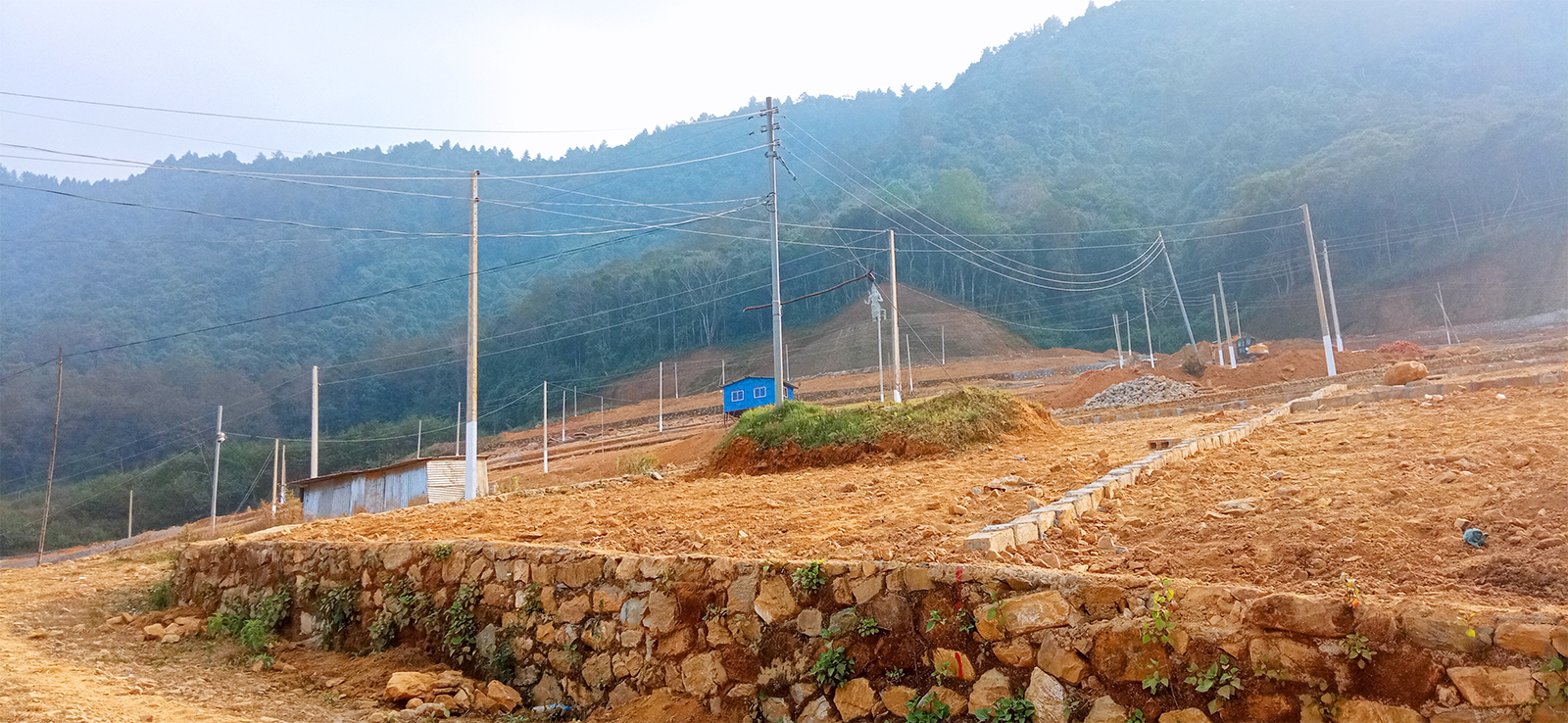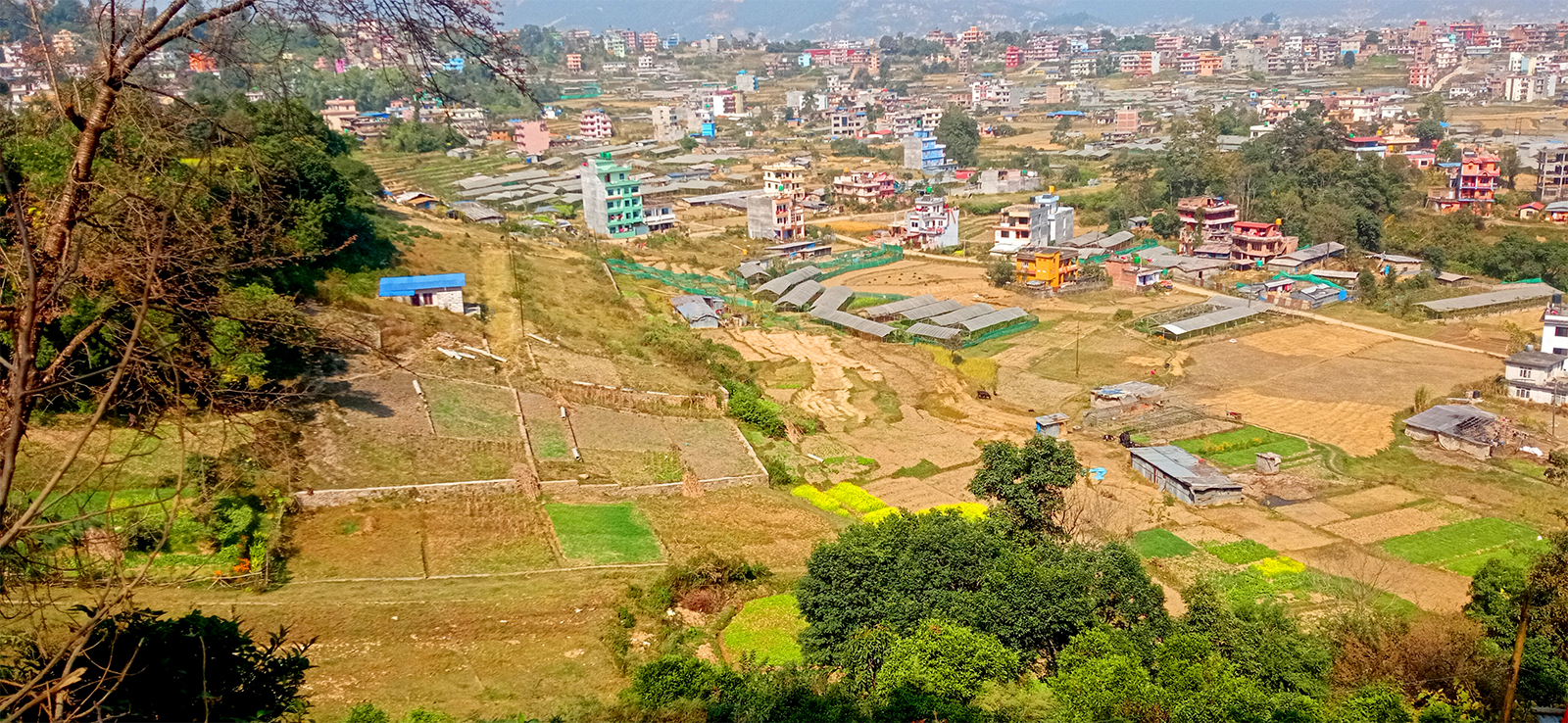Experts warn an agricultural crisis looms large owing to haphazard plotting of arable land.
Seema Tamang | CIJ, Nepal
On June 10, 2022, the plotting of land in Nepal stopped once again as per a decision by the Ministry of Land Management, Cooperatives and Poverty Alleviation. The ministry had made a 12-point decision, which included the provision that recommendation for plotting into agricultural and non-agricultural lands should be done as per the Land Use Act 2076 (2019), and the Land Use Regulations 2079 (2022), under the local government.
A month and a half after Minister Shashi Shrestha made the decision, the local government of the Land Use Council of Kirtipur Municipality on Shrawan 13 declared all the land within the municipality as non-agricultural area. Chandragiri Municipality also declared the entire land within the municipality a non-agricultural area. Like Chandragiri and Kirtipur, many market-centred municipalities within the country are today being turned into non-agricultural areas.
According to Chandragiri Municipality mayor Ghanashyam Giri, all landowners want to turn their land non-agricultural. This is because of the suspicion that agricultural land cannot be sold, and it fetches a lesser price even when it can be sold. The pressure by the landowner can be felt on the Local Land Uses Councils of the local levels.

Mahalakshmi municipality of Lalitpur . Cover picture: Plotted land in Suryavinayak Municipality- 9 Bhaktapur
As per the Land Use Regulations, local levels can classify land on the bases of local needs, land use classification, guideline, and area.
Appendix 1 of the Land Use Regulations has stated that the lands containing fruit garden, nurseries, vegetables and flower cultivation are classified as agricultural land. According to the Regulations, the lands containing artificial ponds for fish farming, grazing terraces within human habitation, grasslands, and areas with trees or bushes are also considered agricultural land.
Local levels, though, are not concerned about it. Municipalities like Kirtipur and Chandragiri classified paddy fields, vegetable gardens, and nurseries as non-agricultural land.
Food insecurity risks
The subject of finishing agricultural land directly involves food security. The Right to Food and Sovereignty Act 2075 (2018) made legal provisions for implementing every citizen’s fundamental rights relating to food, food security, and food sovereignty. The Act has provisions such as: coordination of all three levels of the government for sustainable use of agricultural land, encouragement for cultivation in agricultural land, scientific identification and classification of agricultural land, and control of plotting of agricultural land.
This Act has given the responsibilities of identifying fallow lands and preparing the list of agricultural lands to the local level. However, the local levels have made inappropriate use of a ministerial decision by classifying agricultural lands as non-agricultural to pave the way for plotting.
Damodar Dhakal, director and spokesperson of the Survey Department, says while the decision of the Land Use Council cannot be interpreted otherwise, the classification of the land in this way might invite many problems. According to him, classifying agricultural land in the formal maps as non-agricultural affects agricultural grant programmes.
“That’s why we have requested to classify according to the Land Use Act, Regulations, and Guidelines. Classifying agricultural land as non-agricultural based on commercial interests would result in land plotting and food crisis.
According to the Ministry of Agriculture and Livestock Development, Rs2.8 million was allocated last fiscal year under the Agricultural Development Strategy Programme and the Prime Minister Agriculture Modernization Project in Kirtipur Municipality. In Chandragiri, Rs5.8 million was allocated for the same programme.
During the current fiscal year, Kirtipur has been allocated Rs 2.7 million, and Chandragiri Rs 5.1 million for the same project and programme. According to an official at the Ministry of Agriculture and Livestock Development, the budget allocated by the government goes to the industrial sector if the local level keeps on increasing residential areas in the agricultural sector.
There are also enough examples of land plotting and farmers being unable to cultivate, or cultivation getting complicated. Dasharam Khyaju, a resident of Sipadole in Bhaktapur, has taken on lease residential lands for cultivation of asparagus.
Kumari Tamang, from Nuwakot, who is a paddy and vegetable farmer in Bista Gaun in Kirtipur, is confused about what to do. She came to Kirtipur for her children’s education five years ago, but the landlord sold the land she rented for agriculture for plotting. “My contract is still valid for some time, but the new landowner is intent upon plotting the land to sell it. I don’t know what to do, where to shift.”
Nowadays, Nepal has seen a steep decline in the production of agricultural products. The data on the import of rice reveals the situation of agricultural products in Nepal. According to the Department of Customs, Nepal imported rice costing Rs 15.82 billion in the fiscal year 2071/72. It reached to Rs19.17 billion in the fiscal year 2072/73.
Similarly, data shows that while Nepal spent Rs22.82 billion on rice import in the fiscal year 2074/75, it had reached Rs. 29.04 billion in the last fiscal year.
In July/August 2017, the Nepal government through the constitution decided to control the plotting of agricultural land. As per this, the Ministry of Land Management, Cooperatives and Poverty Alleviation to implement ‘Land Usage Act 2021’ and directed the subordinate departments to execute it.
However, land plotting has not come under control. Gopal Dahit, Minister of Land Reform and Management, himself allowed nine companies and two people to divide the land in October 2017.
Plotting continued, even as excuses were made, including the distribution of wealth among offsprings, implementation of court order, or the option of selling multiple times to turn agricultural lands into plotting.
Faulty land policy
Chakra Pani Khanal, who served as Minister of Land Management, Cooperatives and Poverty Alleviation from March 2017 to August 2018, says the Land Act, 2021 BS, has been used as a means to earn money rather than control the plotting of agricultural land.
“There’s a big game going on in the name of land plotting. Some ministers might stop it for a few months, but they open it after land mafias pay them a bribe. I speak from my own experience and research. I was pressured too, but I didn’t relent,” Khanal said.

Land Plotting in Kirtipur municipality-4 Kathmandu.
Khanal claimed representatives from Parliament to local levels are involved in land plotting. However, the representatives put the blame on the government’s policy related to land.
Raj Kumar Nakarmi, Mayor of Kirtipur Municipality, says forming a national land policy by keeping 50-60 ropanis of land in mind is problematic. The policy of not allowing plotting of land less than 15 aanas is wrong, according to Nakarmi.
According to Nakarmi, one aana land in an urban area is sold for Rs5 million. There are many families who, according to Nakarmi, sell land to run their household. “We have to solve the problems of Kirtipur residents, not the entire country. So, based on the government’s Geographic Information System (GIS), we have declared the entire land of the municipality non-agricultural.
Ghana Shyam Giri, Mayor of Chandragiri Municipality, says there is just a bit of land that remains in the urban area. “It was difficult to build homes in the lands we had declared agricultural in the past. So we have turned the entire land non-agricultural,” Giri said.
Sushila Adhikari, Deputy Mayor of Nagarjuna Municipality, says only some agricultural lands were made non-agricultural after there were problems in trading and building houses. Claiming it is illegal to sell agricultural land, Adhikari said it would be “unfair to those who had yet to sell their land. So we turned all land within the municipality non-agricultural.”
Former Minister of Land and Reform, Khanal, says the game of controlling and releasing the land plotting has been going on since August 2017, adding that it is directly related to corruption.
The then Minister of Land Reform and Management, Gopal Dahit on August 10, 2017 put a ban on plotting of land for sale. However, he withdrew the ban three months later. There were news reports at the time that the withdrawal was due to the selfish interests of nine companies and two individuals.
The minister-level decision had benefitted GharGhaderi.com Pvt Ltd, Om Bahadur Khatri, CD Developers Pvt Ltd, CE Constructions and Shivam Developers.
Similary, Committed Entrepreneur Real Estate, Vibhor Properties, Chandragiri Nagar Colony, Homeland Housing (Sipadol, Bhaktapur), Prakash Acharya (Lalitpur-14), and Homeland Housing Pvt. Ltd. (Lalitpur-14) had benefitted from the minister’s decision.
After a writ petition was filed at the Supreme Court against Minister Dahit’s decision to allow plotting, the top court on February 14, 2018 gave a stay order. Chakra Paani Khanal, who was appointed Minister after Dahit claims he did not relent to the pressure to allow plotting.
Minister Padma Aryal is easier to plot. Aryal, who became minister in December 2018, decided that if somebody came with a letter from the local level that it was not an agricultural land, it could be plotted thrice within a single fiscal year. She later removed all sanctions in August that year.
Minister Aryal’s decision was also challenged by a writ petition. On December 8, 2020, the Supreme Court cancelled the minister’s decision.
Thus, the plotting of agricultural land, which was earlier done by the federal ministry, has now begun from the local level itself. This has raised the risk of the entire country losing agricultural land.
More than four crore units in the country
As per Krishna Bhandari, the spokesperson of the Department of Land Management and Archive, the data of the past five years shows an increase in land plotting every year. “Land plotting is rising each year, as shown by the online records of Land Reform and Land Revenue Departments,” Bhandari said.
According to him, 51,772 units were divided into 134,222 in the fiscal year 2073/74, and 694,213 units were divided into 1,612,135 units in the fiscal year 2078/79. There are more than four crores units over the country.
Plotting projects are ravaging forests, hillsides, and fields. The companies or individuals plotting on their own are not in the ambit of the government. More than 80 companies and individuals are thought to have plotted 1,144 ropanis of land in Bhaktapur. According to Krishna Maharjan of the Office of District Commissioner, only 33 projects have permission to do the plotting.
Upon receiving information about haphazard plotting, Maharjan says, he published a notice on January 20, 2022, claiming he began regular monitoring.
There is a legal provision to withhold the land or levy a fine if an individual or company engages in land plotting without getting project approval. “However, we have not been able to bring them under the legal radar because it is difficult to identify the units they have plotted,” Maharjan said.



